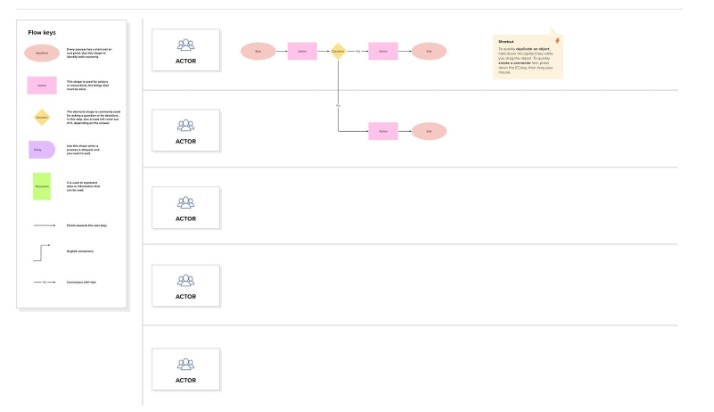- Home
- About Us
- The Team / Contact Us
- Books and Resources
- Privacy Policy
- Nonprofit Employer of Choice Award

 CanadaHelps recently launched Charity Growth Academy, a digital transformation pilot program for the sector, made possible by Mastercard Changeworks™. Through the program, charities will build technical skills, improve their operational processes, and develop digital mindsets by leveraging the training, expert support, grants, and tools available to them. The program is only just beginning, but one of our early learnings so far is about the need to slow down to speed up — that is, taking a step back to strategize, plan, and map out processes so organizations like yours can be more effective in the future. We also want to share new insights as they unfold! From our early work with charities, process maps have quickly become one of my favourite tools.
CanadaHelps recently launched Charity Growth Academy, a digital transformation pilot program for the sector, made possible by Mastercard Changeworks™. Through the program, charities will build technical skills, improve their operational processes, and develop digital mindsets by leveraging the training, expert support, grants, and tools available to them. The program is only just beginning, but one of our early learnings so far is about the need to slow down to speed up — that is, taking a step back to strategize, plan, and map out processes so organizations like yours can be more effective in the future. We also want to share new insights as they unfold! From our early work with charities, process maps have quickly become one of my favourite tools.
Process maps are helpful for visualizing how information moves through your organization, taking into account the people and technology involved – clearly identifying bottlenecks, repetition and delays. It can also help with brainstorming ideas for process improvements, increase communication and provide documentation to define process boundaries, ownership, and responsibilities. All of which keep the efficiency of your organization, no matter how big or small, at the forefront of everything.
Documented process maps are also an important piece for onboarding new staff, and understanding how the work of different departments fits together.
1. Brainstorm the process steps: Gather all information from start to end: steps, inputs, outputs, roles, time duration. Every detail is important. Think about explaining this process to someone completely new: what would they need to know to be successful, and where they would get held up if a step was left out. Aine McGlynn, a technology consultant supporting Charity Growth Academy, describes this step really well, saying “Think about what you need to know to bake a cake. What if the recipe left out amounts, or oven temperature, or time to bake - would it be successful?”
2. Determine the process boundaries: What is the specific point when the process starts, and when does it stop? Coordination between one process and the next may be required and this is a good time to identify crossover or independence.
3. Organize the process steps: Arrange the steps in a sequential order. A swimlane diagram can be a great tool for mapping out a process. These flowcharts document the full process, and also make clear who is responsible (or what technology is being used) for each step. You can make your own swimlane diagram using a free board on tools like Miro or Mural.
4. Share the map with all stakeholders: This is important. It is imperative that all stakeholders agree and align with the process and the steps involved in it. Some helpful questions to ask at this stage include: Will team members follow the charted process? Is everyone in agreement with the process map flow? Is anything redundant? Are any steps missing? Once consensus has been reached, the process map is ready to be implemented.
You can go through this exercise anytime you are adding a new program or project, and should review it when changes are made to ensure the documentation remains accurate.
A Charity Growth Academy participant putting process mapping into practice
Sampada Kukade, Director, Employer Engagement & Partnerships, and Program Marketing at Skills for Change, is working on process mapping with her team as part of the Charity Growth Academy pilot. They’ve used this work as an opportunity to document all the processes in the organization, look for places where actions overlap, and use the information to choose better processes and tools to improve. It’s also an important knowledge and team building exercise as the leaders across the organization come together and understand the details of each other’s work, creating larger opportunities for cross-organization collaboration. Says Kukade:
“The key to our success to date with digital transformation has been through process mapping to identify the different workflows across the Agency, to inform how we improve and streamline these workflows, and facilitate a smooth deployment of digital tools and adoption by staff. In addition, process mapping has allowed for our organization's leadership team to better understand how our work fits as a whole, with the spirit of collaboration.”
What challenges are you and your organization facing today?
Whether you are struggling to develop a segmented donor communication program, seeking new efficiencies in program delivery, or trying to ensure organizational knowledge is easily accessible to the right people, process mapping can help and it’s easier than you think.
Lizz Bryce is SVP, Community & Strategic Initiatives at CanadaHelps, a leader in providing powerful fundraising and donation technology to charities and donors since 2000. She has spent nearly a decade with CanadaHelps as a key part of its leadership team, and is the Project Lead of the Charity Growth Academy, a new digital transformation program for charities by CanadaHelps.
Image Credit to Mural